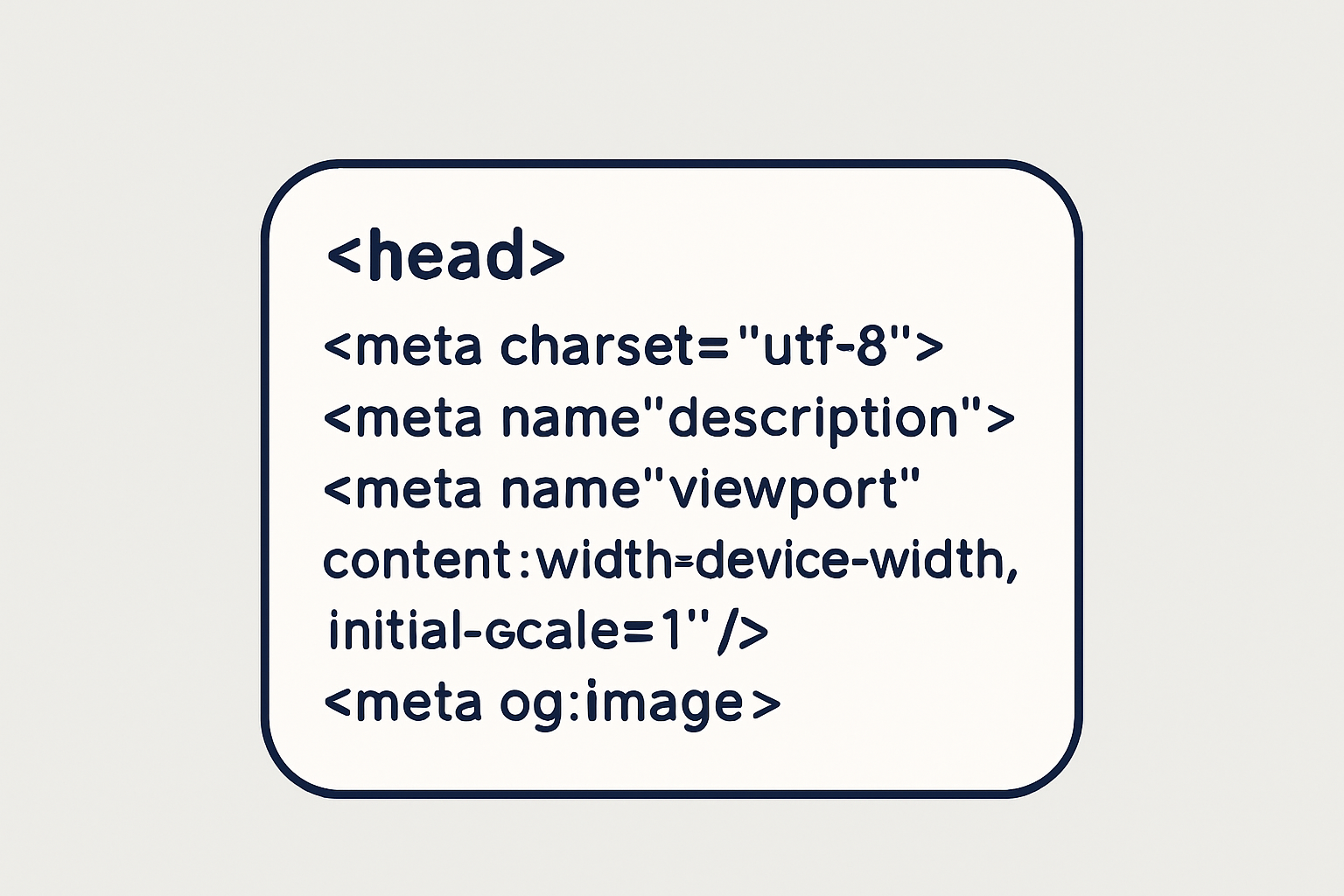
The Complete Guide to Local SEO for Restaurants
Discover how local SEO can transform your restaurant's online presence, bringing in more nearby dine...

Meta values are the unsung heroes tucked inside the HTML <meta> tag. They quietly provide vital information about a web page. Browsers, search engines and many other digital helpers rely on this information to understand what’s going on. When used correctly, meta values organize a website’s structure and improve its accessibility while boosting its search engine optimization (SEO).
The <meta> tag is an HTML element placed inside the <head> section of a document. It stores metadata—behind-the-scenes information that browsers and search engines rely on but you won’t see on the page. Meta tags provide important details such as character encoding, page descriptions and keywords, and browser instructions. These details help the page render smoothly and get indexed correctly.
Meta values pack a punch when conveying key details about a web page in a way that machines can swiftly understand. They help browsers and search engines get the gist of the page's context and layout without breaking a sweat. Choosing the right meta values usually boosts your SEO and smooths the path for search engines to interpret your content the way you intended. Plus, they’re a quiet champion for accessibility, ensuring assistive technologies work well and users don’t get stuck.
Meta tags usually come with a handful of key attributes like charset, name, content and http-equiv. The charset attribute sets the character encoding—most often UTF-8, the trusty go-to these days. The name and content attributes deliver descriptive metadata covering essentials like keywords, descriptions and the author. The http-equiv attribute plays a role similar to HTTP headers and can subtly influence how browsers handle the page behind the scenes.
| Meta Attribute Type | Example Meta Value | Purpose | Impact on HTML Document |
|---|---|---|---|
| charset | UTF-8 | Sets the character encoding used in the document | Makes sure your text looks just right, no matter the browser or device |
| name | description | Provides a brief summary of the page content for SEO | Helps search engines whip up relevant preview snippets, so people know what they’re in for |
| name | keywords | Contains important search terms related to the page | Gives SEO a little nudge by highlighting the key topics that matter |
| name | author | Identifies who created the content | Adds a personal touch by recording who’s behind the scenes |
| name | viewport | Manages how the page is shown on mobile devices | Keeps layouts neat and responsive, making sure it looks good on all screens |
| http-equiv | refresh | Automatically reloads or redirects the page after set time | Takes care of refreshing or redirecting without you breaking a sweat |
| http-equiv | content-type | Defines the MIME type of the document | Helps browsers figure out how to display the content properly, no guesswork involved |
Let’s dive into the world of character encoding—a topic that is easy to overlook until the moment your text starts looking like a bunch of gibberish. Understanding the charset meta value is one of those subtle but vital details that can save you from unexpected headaches down the line.
The charset meta value basically tells the browser which character set to use when displaying text, and UTF-8 is the preferred option for almost everyone. Placing the charset early in the <head> is a smart move because it helps browsers decode characters properly. This prevents those annoying garbled texts you sometimes see, especially with languages that have special symbols or accented letters.
Sometimes, the devil really is in the details—especially when it comes to meta values. These little gems tucked into the name and content attributes can make a world of difference, helping everything stay crystal clear and effortlessly organized. Whether you are a seasoned pro or just dipping your toes in, giving these values a thoughtful touch can save you headaches down the road and keep your projects running like a well-oiled machine.
Descriptive meta values bring together the name and content attributes to deliver key metadata about the page. You’ll commonly bump into names like description, author, keywords and viewport. Clear and concise descriptions paired with spot-on keywords can really give your SEO and accessibility a leg up. The viewport meta tag is the unsung hero that helps pages behave nicely on mobile devices by adjusting scale and dimensions just right.
The http-equiv attribute lets you mimic HTTP response headers inside the HTML document—pretty handy. Values like refresh and content-type send instructions to the browser that steer how caching works, how content is interpreted, and when redirects come into play.
Meta tags are usually placed near the top of the <head> section, beginning with the charset to avoid any encoding issues. After that, make sure your descriptive meta tags stand out with clear and unique content that leaves no room for confusion. Keeping these tags well organized and avoiding duplicates or conflicting information not only helps browsers and SEO tools but can also improve your page's performance and visibility.
One classic pitfall with meta values is keyword stuffing, which usually ends up doing more harm than good for your SEO and credibility. A lot of newbies often fumble the viewport meta tag, which can sadly turn a smooth mobile experience into a bit of a headache. Then there’s the tricky business of http-equiv attributes using them the wrong way might cause annoying page refreshes or caching glitches you didn’t bargain for.
Think of meta values as those little labels and special instructions you find stuck on a package. They’re not part of the box’s artwork, but they quietly do the heavy lifting—telling the delivery people how to handle the package and making sure it lands exactly where it’s supposed to go, safe and sound. Kind of like how meta tags guide browsers and search engines behind the scenes.
A webpage's head section includes trusty meta tags that quietly work behind the scenes to boost your SEO, ramp up responsiveness and make social sharing look snazzy. For example, setting the charset to UTF-8 tells your browser "Hey, show this language the right way" so nothing gets lost in translation. The description tag plays the starring role in how your page shows up in search results. Then you have got social media tags like Open Graph that craft richer previews on platforms like Facebook and Twitter and make your links more eye-catching.
Nail down and specify your document’s character encoding using the trusty utf-8 charset meta tag. It’s a small step that saves a lot of headaches later on.
Whip up a clear and to-the-point description meta tag that genuinely captures what your content is about. This boosts your search visibility.
Pick relevant keywords that truly match your page’s content but keep it balanced so you do not cram the tag like a packed suitcase.
Double-check that your viewport meta tag is set up right to ensure your design flows smoothly on all devices.
Don’t shy away from using online validators or SEO tools like Semrush or Ahrefs to give your meta tags a thorough once-over and make sure they’re pulling their weight.

An example of a well-structured HTML <head> section demonstrating various meta values in use
Advanced meta tags bring a bit of semantic flair to modern web features. Open Graph and Twitter Card meta tags are the unsung heroes that make your content pop when shared on social media kind of like dressing up for a virtual party. Then you’ve got custom meta tags that take care of web app manifests or even nudge mobile browsers to behave the way you want.
og:title and og:description set the title and summary that pop up in social media previews, giving your links that extra bit of shine.twitter:card controls how your content looks on Twitter, including those snazzy rich media cards that really catch the eye.theme-color lets you tweak the browser toolbar color on supported mobile devices, adding a nice personal touch to the browsing experience.mobile-web-app-capable flags whether a website can behave like an app on mobile platforms, making things feel a bit more seamless.noindex or nofollow whisper to search engines how to crawl or avoid links on your pages.Adding these advanced meta values developers bring in extra layers of meaning and control that go beyond the usual HTML metadata. This smarter setup tends to smooth integration with social platforms and boost user engagement while keeping applications running reliably across different devices.

Discover how local SEO can transform your restaurant's online presence, bringing in more nearby dine...

Master web development SEO with this practical guide using Semrush. Learn to audit, optimize, and tr...

Discover step-by-step restaurant SEO techniques that will enhance your local visibility, attract nea...

Discover the best internet archive alternatives tailored for different budgets and data preservation...